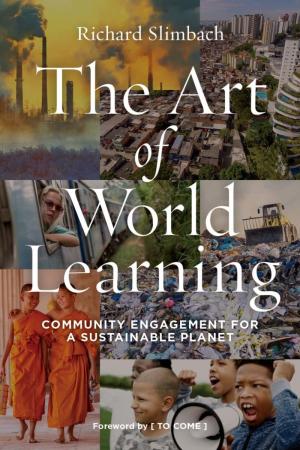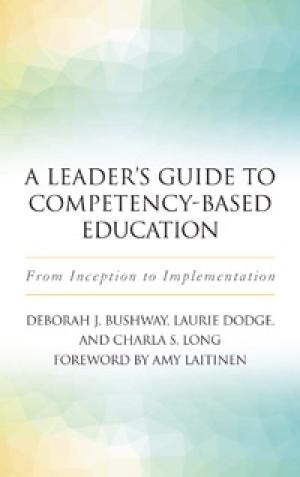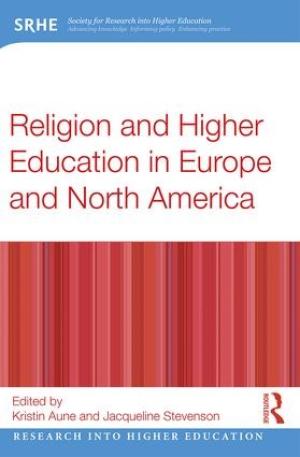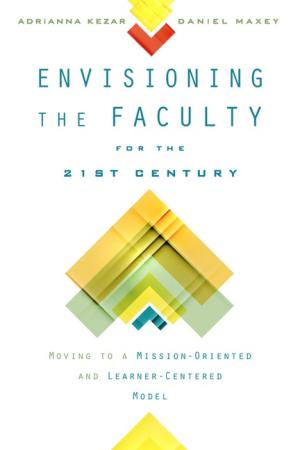Resources by Barbara J. Blodgett

This is a visionary, consciousness-raising book that asks us to rethink the purposes and design of study away and study abroad experiences in the context of a broadened set of global threats, including climate disruption, soaring inequality, ecosystem breakdown, the dying off of distinct languages and cultural communities, and the threat of a nuclear catastrophe. As we ask students to truly comprehend this world from the privileged perspective of the global North, Rich Slimbach asks us to consider two fundamental questions: What and how should we learn? And having learned, for what should we use what we know? A panoply of pedagogies and methods of inquiry – from study away/abroad and service-based learning to diversity programming, environmental education, and community-based research – aim to develop students who both understand the challenges faced by global communities and act in ways that advance their social and environmental health. What temperaments, social habits, and intellectual abilities will they need to help heal their corner of creation? And what pedagogical perspectives, principles, and procedures can best support them in this creative challenge? Rich Slimbach argues that transforming student consciousness and life choices requires a global learning curriculum that integrates multi-disciplinary inquiry into the structural causes of problems that riddle the common good, along with mechanisms that bid students to cross borders, to pay attention, and to listen to those unlike themselves. At its heart, this book proposes a truly transformative approach to community-engaged global learning. (From the Publisher)

I have just experienced a new first in my teaching career: This week I had to re-design a course for a face-to-face format from an online format. I recently switched jobs. After teaching for half a dozen years in a school that exists primarily online, I am now back in a residential context, working for a school that exists primarily on a brick-and-mortar campus. I have been invited to teach a course next year, and I thought it would be a simple matter to adapt one I had offered at my previous institution. So, without hesitation, I accepted the invitation. Then, the Registrar asked me if I could teach in the school’s evening program—one class session per week for 2’45”. Two hours and forty-five minutes?! I realized with a gasp that I no longer knew what I would do with such a sustained block of time. Lengthy lectures are a thing of my distant past. When I first started teaching online, I had to work to pare my presentations down to twenty minutes. Recently, I attended a workshop where I learned that the average student attention span--before the mind starts wandering--is something like nine minutes. “Limit your presentations to twelve minutes, max,” the leader admonished us, “and even then, make them funny or catchy in some way.” Discussion, of course, can use up a lot of minutes. But there, too, I have become accustomed to disciplined time management. I developed the habit of checking in to my online course discussions daily, spending only about thirty minutes monitoring and guiding each thread; an hour, max. Online courses have so many elements to attend to that online instructors learn not to get sucked too deeply into every discussion. I forced myself to recall what I used to do in the old days of classroom teaching because I had a vague memory of class sessions flying by with never enough time before students were stuffing their books into backpacks and dashing out the door. Oh, right: Debates. Case study exercises. Role plays. Problem-solving. Guest speakers. In-class writing. All of which, I realized, I had at one point modified for the online environment. Versions of these learning activities still populated my syllabi; it was just that they happened in smaller chunks, spread throughout a week rather than concentrated in an evening. In addition to how differently time gets used in online vs. face-to-face teaching, my conversation with the Registrar also brought to mind the difference between virtual and live presence. I realized that I would once again have to muster up the energy to regularly face a room full of live bodies. Would I have to stand on my feet in front of them the whole time? Would they sit there and stare at me? I recalled the adrenaline rush that always made my palms a little sweaty before walking into class and the dissipation that left me feeling drained for several hours afterward. For six years my body had been spared all that. You don’t get particularly nervous sitting in your familiar, quiet office reading discussion posts, watching videos, and answering emails. And if for some reason you do, you can always take a break and leave for a walk or a snack or even some errands, with no one becoming the wiser. Speaking of quiet, I started recalling how noisy classrooms could sometimes become. Or, worse yet, pin-drop silent. I sighed, remembering the dual agonies of having to cajole speech out of taciturn participants and having to serve as traffic cop during swift-moving exchanges where everyone talked at once. Like all students, online students naturally vary in terms of their participation levels, but the format makes it possible to require that all of them contribute at least the same minimum to every activity. As another blogger in this series put it, “Discussion dynamics online become more democratic when each student is equally invited and expected to contribute to conversation” (Miriam Y. Perkins, “How Teaching Online Enhances Residential Pedagogies: The Big Picture,” Online Teaching, Online Learning, February 12, 2019). I am confident that come next year when I am teaching again in a traditional classroom, I will re-adapt, and eventually relish the immediacy and liveliness and spontaneity it affords. But I am also reasonably confident that I will miss the steady, measured egalitarianism of my former online world, and the kind of teaching it made possible.

Recognizing the growing interest in competency-based education (CBE) in U.S. higher education, but also the lack of shared standards or practices around it, three experts produced this guide for other educators who are contemplating a move to (or revision of) this type of instructional program. The authors help those who are enthusiastic about CBE avoid pitfalls by offering practical guidance. They strike a cautionary tone throughout, beginning their Introduction with the sobering reality that “there are relatively few schools that have been able to move from interest to implementation” (1). One of the reasons for caution may be that even a definition of CBE is hard to come by. The authors joke that “if you were to ask ten people to define CBE, you would likely hear ten different answers” (2). Instead they offer five “hallmarks” of CBE: (1) “time is variable, and learning is fixed”; (2) there is “required demonstration of mastery or proficiency” which is (3) “determined by rigorous assessments”; CBE is (4) “focused on the student learning journey” and is (5) “offered in a flexible, self-paced approach” (3-4). Many educational programs would claim one or more of these hallmarks, but taken together, they represent a distinct departure from traditional education. CBE’s most famous feature may be the way it changes the relationship between learning and time by replacing the credit hour with continuous direct assessment. As the authors demonstrate, however, this change complicates everything from the transcript to faculty workload to accreditation. CBE’s intense focus on individualized student learning paths and assessment (“assessment on steroids,” as I once heard) is also significant because it changes what learners actually do to learn and what teachers do to teach. Traditional faculty roles are likely to be unbundled, “reassembled” (89), and redefined – or replaced – by roles like coach, tutor, and psychometrician. Given the challenge of defining CBE and the guide’s relative brevity, it would benefit from some case studies, at least for readers who are still trying to gain a clear picture of what a CBE program looks like and why an institution might adopt one in the first place. Cases would presumably also help CBE adopters appreciate why other institutions made the choices they did. The book reads instead like an insider’s guide. The book’s best feature, accordingly, is its soup-to-nuts review of issues that educators must consider when designing competency-based education. Chapters address institutional culture, program design, assessment strategies, staffing and business models, and approval seeking. Readers come away fully aware that CBE is not just a different teaching approach but a potentially radical disruption to education delivery.

In theological education, students who go to school online are frequently students who remain at home throughout their degree programs serving in faith communities they know well. This reality affects their formation and affects how teachers approach it. There are some advantages to the situation. As Elaine Ramshaw writes about teaching pastoral care online: “The fact that many of the students are also concurrently doing what one might call ‘embedded’ parish work, and that some of them are the pastoral leaders of their congregations, can be a plus for teaching in any of the practical fields.”[i] For example, in a class on pastoral leadership I might teach students how to lead decision-making via consensus process. An assignment option for that class might then be to lead their church board through consensus process. Assignments carried out in students’ ministry contexts represent what in higher education are called “authentic assessments.” Defined as real-world activities mirroring the very sorts of tasks students will practice in the professions for which they are preparing, authentic assessments are widely valued for their role in formation. They are also sometimes perceived to be tricky to create. But when online students can simply turn a camera on in the place they already work, authentic assessment becomes easier. I have learned several ways to take advantage of the video camera in assessing ministerial formation. The first thing I tell students is that because it is their development I care about, I will be watching and listening to them, not their congregants. They should train the camera on themselves and not worry about capturing everybody on film. They will upload the video to a secure channel, I will be the only one viewing it, and they can delete it once I have done so. Moreover, I tell them, I’m not assessing their congregants. Activities do not have to go perfectly for me to get a sense of students’ leadership abilities. Whether or not, for example, their board actually reaches consensus on a decision is not the point. These reminders help students help their folks to relax, act naturally, and forget about the camera. The hope is that I will, in fact, see a truly authentic ministry event. It appears to work. The video camera becomes quite literally like a fly on a wall that ceases to be noticed after a while. Therefore, filming has certain advantages over direct personal observation of students, which in face-to-face education is often considered the ideal way to assess student formation. The second thing I tell students is that they must watch their videos. I was surprised when I first started teaching online to discover how often they did not. I appreciate the self-consciousness and even pain associated with seeing a tape of oneself, but one of the best ways to learn how to be a minister is to watch oneself in the act of ministering. Videotaping uniquely allows for this kind of learning. The third thing I tell my students is that by watching a video of them in action, I will learn more about their context and gain appreciation for the challenges they face. The videos give me access, after all, not only to students whom I would never see otherwise because of distance, but also to real conversations being held in real church parlors, basements, and Sunday School rooms. It doesn’t get more ‘authentic’ than watching a bunch of folks sitting around a table sipping Diet Cokes, quieting fussy babies, and occasionally digressing from the exercise at hand to rehash last night’s big game. Watching the videos makes me realize how difficult the skills I’ve taught in class can be when practiced authentically. I cannot help but see what goes on. I see all the distractions and interruptions that come with trying to get church folk to have a serious conversation. I’ve watched my students struggle to manage dominant personalities, deflect obvious attempts at alternative agendas, and finish exercises in time to get to the second service. I have even watched somebody suffer a stroke in the middle of a meeting. A final advantage of authentic assessment via videotape is that teachers come to appreciate the true breadth and complexity of ministerial formation. [i] Elaine Ramshaw, “Reflections on Teaching Pastoral Care Online,” Reflective Practice: Formation and Supervision in Ministry, Volume 31 (2011), 62. This entire volume of Reflective Practice is dedicated to formation and supervision in a digital age.

“I feel like I’m constantly grading now.” My colleague’s comment was offered as a lament over so much more assessment now that our school had transitioned to an online curriculum. That online courses required more grading was a surprise, and a mystery, to me at first too. Why should the delivery format make such a difference to how a course gets graded? There is an answer to that question, and the nature of learning provides the answer. Online learning is learning mediated by distance and time. It doesn’t have the same social component, or the immediacy of interaction, that learning in class does. Going to class—and therefore, presumably, learning—constitutes the primary blocks of a residential student’s day, but learning done by students in an online school is often piled onto or squeezed into a daily schedule that is not otherwise centered around education. Online learning, therefore, occurs in isolation from many of the reinforcements to comprehension, inquiry, and creativity provided by face-to-face environments, e.g., shared space, informal conversation, direct and immediate access to professors, and even simple sensory aids like handouts, refreshments, show-and-tell objects, and rituals used to begin and end class. These sorts of things all contribute, in face-to-face education, to creating a learning environment that marks the moment of learning: “Now, here, learning is happening,” they convey. In other words, they help sustain student engagement. Online instructors must find other ways to achieve what going to class achieves for residential students. We have to design our online courses in ways that grab our students’ attention and keep them motivated as they progress. We learn to employ strategies that encourage students to logon frequently, help them feel present within the online space and online community, provide them with frequent opportunities to verify their understanding of course content, to ask questions, to participate in discussion, to receive feedback, and to see their progress. Frequent, small assessments constitute one of these strategies. They play a role in a larger ecology of learning that has many points and modes of engagement. Certainly, instructors can overload a course with too many little tasks and activities, but, generally speaking, lessons that are chunked into multiple small assignments keep students more engaged than do lessons consisting simply of reading and discussion—leading up to a big test or paper at the end of the course. In addition, when those smaller chunks are graded, students must complete them in order to succeed in the course. Grading creates a point of connection between student and professor, especially if it includes feedback and not just a number. As they accumulate, grades can provide students with a visual picture of their progress. This is the reason why online education can involve so much grading. It’s about engagement. It isn’t necessarily about the need to measure or evaluate every single thing an online student does. One does not even have to award numbers or letter grades each time. (Continually having to decide where student work falls on a grading scale is what tires instructors like my colleague.) The larger point is that student engagement and motivation are keys to successful learning in general, no matter the delivery method. And this is what teaching online, with its seemingly endless assessment, has taught me about learning. There are many studies proving the connection between engagement and learning. Since I cannot do justice to them here, I will close by reflecting on my own experiences as a learner. Like many future academics, motivating myself to learn was never particularly hard and I got to study things that naturally aroused my curiosity. I did not need bells and whistles to make me interested. But there are always exceptions. When learning is obligatory or seems irrelevant, it’s been the graded assignments that have spurred me on. Several years ago, I had to take a course in driver safety to be allowed to shepherd students on field trips. The course didn’t involve any actual driving but, rather, watching videos and taking a test. I was largely bored and disengaged until it was time to be tested. Then my competitive nature kicked in. When I passed with a nearly perfect grade but did not receive 100%, I wanted to take the course over again! To this day, I still remember the driving rule that I got wrong on that test.

When you teach online, you get accustomed to classroom teachers telling you they can’t imagine not being in the same place at the same time as their students. Usually what they dwell on is not being in the same place. They profess difficulty imagining being geographically distant from their students. They question how it’s possible to teach without the body language, visual cues, tone of voice, and the like, that the physical proximity of being together in a classroom affords. Perhaps because I came to online teaching from a background in field education where, by definition, my students left campus to go somewhere else to learn, and in denominational leadership, where leading phone conferences with participants scattered across the country was the norm, I was not overly daunted by the prospect of communicating with people in other places. What I knew would be challenging is the lag in time. I had always relied on the immediacy of classroom teaching. There are some people whose thoughts come out of their mouths perfectly formed into sentences whose meaning is crystal clear. I am not one of them. I tend to economize too much with my words, or make leaps of logic in my head, or have to backtrack to fill in context. When people are taking in what I’m saying at the same time as I’m saying it, however, I can compensate. I am pretty good at quickly sensing what I need to clarify. I am most comfortable when teaching is like a dance and I can use my partner’s responses in real time to make it work. When you teach online, the song can be over by the time you realize that your students never got into the rhythm and have danced a different dance. The hallmark of asynchronous online education is that students are working at different times throughout the week, entering and exiting the class at their own pace and paying you attention on their own time. Their engagement with you and with the material may be just as high as in a classroom, but its timing will be unpredictable. You simply cannot know when a comment or explanation from you will finally reach them. And students experience the same thing, of course, from you. Unless you are willing to log in to the course every hour of every day, their question or confusion might not get addressed right away. Sometimes what happens while you are gone, therefore, is that a misguided thread of discussion can take on a life of its own, a set of odd assumptions can be built up about the reading, or simple errors in the assignment compounded. What I have learned about communication in online teaching—to switch to a different metaphor—is that it bears similarity to letter writing. You write down your thoughts, hit Send and put them into cyberspace, and hope they reach your reader in good time. Then you wait to know whether your words made enough sense and what your correspondent thinks of them. If the correspondence is important, sometimes you find yourself anxiously going to your mailbox over and over again to see whether anything has been delivered back to you yet in the post. The comparison between online education and letter writing is ironic to say the least. Usually we think that technology serves to speed everything up in our lives. But it is instructive as well. In the old days of letter writing, we used to take care with what we wrote, and there were conventions that helped us convey meaning. Usually we started with a few references to our correspondent’s most recent missive to us, commenting on their news. Then we would hit the highlights of our own, sharing some content and then reflecting on it. We often concluded with questions for the other to answer the next time they wrote, in part to encourage a swift reply. In online teaching I have learned to take almost excruciating care to frontload what I am trying to teach and to explain ideas and instructions in detail. I try to learn who is in class before it starts so that I can scaffold my teaching upon their experience. I communicate the most important ideas of the course as clearly as I can and follow with some pointed questions to invite them into the discourse. And then I wait and let time do its work.

When I arrived on campus as a first-year student, I had the name of an economics professor to track down, given to me by close church friends who knew that he and his wife belonged to a church in my new college town. When I knocked on his office door, he was both delighted and surprised; “I assumed you’d come about enrollment in my seminar. No student has ever asked me about church.” Four years later, he celebrated my graduation with other members of the church I’d faithfully attended. Admittedly, I was an outlier. But my story helps dispel the myth that college is a place to go to lose your faith. Widespread assumptions hold that campuses are secularized spaces where religion surfaces only when it becomes a threat (“Fundamentalist students might endanger others”) or a nuisance (“Religious minorities might protest intolerance”). Contributors to Religion and Higher Education in Europe and North America argue that ordinary, everyday religious experience on campus is more common, less problematic, and more nuanced than many realize. Editors Aune and Stevenson collected thirteen essays by researchers and theorists representing different disciplines and approaches who are all curious about how students negotiate the university environment. Section One shares findings from survey research demonstrating, for example, that when it comes to retaining their religious affiliations, practices, and beliefs, students differ from non-students of the same age only in identifying even more strongly with mainstream religious institutions upon graduation, and in shedding their belief in miracles. Other research shows that all groups, including the ‘nones,’ encounter campus climates hostile to their worldviews. This section tries to render empirical the question of secularization and higher education. It affirms both that religion is a slippery thing to measure and that more research is necessary. Section Two presents qualitative research into the experience of being religious in ostensibly secular British, French, and Canadian universities. It challenges the idea that as a pluralistic, secular ethos grows at the institutional level, loss of faith results at the personal level. Becoming friendly to students’ faith would mean, among other things, ceasing to bracket religion as something purely private and propositional, moving beyond mere tolerance and accommodation toward formation of the whole person, expanding vocabulary beyond the moderate/radical binary (Islam), and creating safe and inclusive space for all. Section Three argues for evidence-based institutional policies that treat religion as a social practice rather than an identity characteristic. One chapter addresses the relationship of religiosity to teaching and learning. Contributors call upon institutions of higher education to promote literacy, connection, and dialogue with respect to religion rather than continuing to fall back on the impersonal, secular, and reductionist norms of civility and free speech. In other words, secularity is not neutrality, and the college or university is not ultimately an arbiter of conflict but rather a pedagogical community. This thought-provoking volume, which deliberately addresses higher education outside the United States, will interest several audiences, including campus life personnel, sociologists of religion, chaplains, teachers, and administrators

A conservatory of music in my hometown annually brings to campus a famous singer who leads a master class for its voice students. This is a ticketed event open to the public and regularly draws a large audience. It’s simply fascinating to watch the singer teach. One by one, students come on stage, they perform pieces they have practiced for the occasion, and she offers her critique. Occasionally she offers a mini-lecture on some aspect of singing but mostly she makes students work certain sections of their pieces over and over, all the while offering correction, advice, and support. The audience hears how their music – which sounded pretty good, to begin with – improves with her coaching. While a master class is not the same thing as a studio, the two pedagogies share certain features. In my experience, teachers of religion and theology rarely make use of studio pedagogies; this book made me realize that we should. Studio pedagogy is typically defined by the following elements: lengthy design sessions conducted in large spaces where materials are readily available and works-in-progress can be publicly and permanently displayed. Instructors roam the space, stopping at individual desks to offer feedback that gets intentionally overheard by nearby students. Lectures and discussions are rare; studio pedagogy relies instead on coaching, modeling, correcting, responding, affirming or questioning choices, and occasionally offering on-demand content instruction. It combines authentic learning theory, constructivism, socialization into a profession, and the theories behind flipped classrooms and communities of practice. It shares features of other student-centered pedagogical approaches such as problem-based learning and service learning, although it focuses more on the process of students taking iterative steps toward a final, deliverable product of their own choice and making. This book is an edited volume presenting fifteen narratives by design instructors describing the studio courses they teach in fields like architecture, interior design, and instructional design. Contributors describe the joys, challenges, concerns, and vulnerabilities they have experienced through this sort of teaching. Overhearing their honest confessions and reactions is one pleasure of reading this book, and it gives the reader a taste of what being in a studio is like. This volume is also designed like a studio in that its editors explicitly eschew analysis and summary, preferring instead to “curate” the narratives and let readers draw their own conclusions. Indeed, religion and theology teachers might have to work hard to relate this book to their contexts. It will be most directly applicable to those in field education and those teaching certain kinds of performance or design – preaching, worship, ritual, or religious architecture. Yet its implications are valuable to all who are intrigued by non-native pedagogies. As I read, I kept asking myself, “Why do we keep our critique of student work private?” As one contributor points out, it is often when budding academics begin to share our work publicly that we take it more seriously, find it more gratifying, and believe it has value. Why shouldn’t our students experience the same?

What functions occupy your time as an academic? Are they equally respected, sensibly arranged, and fairly evaluated? Are they well-coordinated with the mission of your institution? Do they complement the functions your colleagues carry out? Do they all contribute to student learning? If you have ever wondered about such questions, you must read this book. Adrianna Kezar and David Maxey, of the Delphi Project on the Changing Faculty and Student Success, gathered a distinguished group of contributors to produce this volume on the future role of faculty in U.S. higher education. They start by pairing two concerns often considered separately despite their proven interconnection: the erosion in recent decades of the traditional faculty model (the full-time, tenured or tenure-track faculty member), and student success. The unbundling of faculty roles, and the consequent re-distribution to assorted academic personnel, of curriculum development, course design, content delivery, assessment, advising, research, community engagement, and so forth—has negatively affected faculty-student interactions and therefore student learning and self-efficacy. Adjunct faculty members are not the problem. Even the disappearance of tenure is not the problem. The problem has been the random, reactive, and poorly conceived responses to market forces and technological revolutions in education. The volume goes on to raise many other concerns that changes to the faculty have effected, including: an evolving understanding of academic freedom based less on individual rights and more on collective responsibility, the way that internationalization of higher education and a global academic workforce challenge assumptions about U.S. supremacy, the need to base faculty evaluations on the success of the department as well as individual achievement, a shift in faculty development programs from mere technology training toward adult learning, and the pros and cons of customizing academic careers to support work-life balance. Contributors do not uncritically valorize the traditional faculty model; while they generally support the return to more full-time positions, they also recognize the need for flexibility and coordination in the design of faculty roles, alignment of those roles with institutional priorities, and collaboration rather than competition among communities of scholars. One specific innovation lifted up as noteworthy is the way medical schools have created multiple tracks (investigator, clinical-educator, clinical, research, and educator) that provide distinct but parallel career pathways for their faculty while simultaneously serving their institutional needs. Though the book does not conclude with a fully envisioned alternative model for the 21st century, several points of consensus do emerge, especially around the need for collegiality, professionalism, responsibility for students, differentiation and diversification of roles, and more expansive definitions of research and scholarship. This collaboration is a rare and refreshing example of one to which the contributions are evenly strong. Every chapter piqued my interest. Readers of this journal may especially appreciate the chapter on academic freedom because it is written by a religion scholar and has a familiar ring. Readers new to the literature on developments in higher education might first want to read Ernest Boyer’s 1990 Scholarship Reconsidered, referenced frequently by contributors. Envisioning the Faculty for the 21st Century will become an equally important and influential work. Works Cited Boyer, Ernest L., author. Drew Moser, Todd C. Ream, and John M. Braxton, editors. 2016 expanded edition. Scholarship Reconsidered: Priorities of the Professoriate. San Francisco: Jossey-Bass.